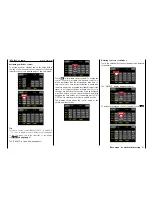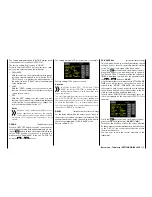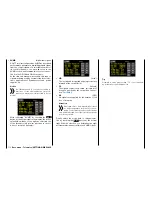
The setting programmed under "MODE"
always
refers
to the channel set in the line OUTPUT CH.
The factory setting for all servos is "HOLD".
For each selected OUTPUT CH (receiver servo chan-
nel), you can select between the following:
• FAI(L) SAFE
With this selection, the corresponding servo moves
into the position displayed in µs in the line "POSI-
TION" in case of a malfunction after expiration of
the delay set in the "DELAY" line for the remainder
of the malfunction.
• HOLD
With the "HOLD" setting, over the course of a mal-
function, the servo remains in the last correctly re-
ceived servo position.
• OFF
With the "OFF" setting, over the course of a mal-
function, the receiver stops transmitting (buffered)
control pulses for the relevant servo output. The
receiver switches the pulse line "off".
Notice
Analogue servos and many digital servos no
longer experience resistance to the ongoing
control pressure after control pulses stop and
are moved out of their position at greater or lesser
speed.
F.S.POS.
(Fail-Safe position)
For each OUTPUT CH (receiver servo connection), af-
ter activating the value field (red parameter) by touch-
ing the
SET
button at the bottom right of this display,
set the servo position for the servo to assume in a
malfunction in "FAI(L) SAFE" in the line "F.S.POS." by
using the
INC
or
DEC
buttons.
The setting is made in 10-μs increments, for example:
Factory setting: 1500 μs (servo center).
Attention
In all three modes "OFF", "HOLD" and "FAI(L)
SAFE", the function "F.S.POS." is particularly im-
portant when waiting for a valid signal after turn-
ing on the receiver:
The servo immediately moves into the fail safe positions
set in the "POSITION" line. This prevents landing gear
from retracting when the receiver is accidentally turned
on while the transmitter is off. In normal model opera-
tion, the corresponding servo contrastingly acts accord-
ing to the set "MODE" in a malfunction.
DELAY
(fail safe reaction time or delay)
Set the delay after which the servos are to move to
their set positions when the signal is interrupted. This
setting is adopted by all the channels and only affects
the servos programmed for "FAIL SAFE" mode.
Factory setting: 0.75 s.
FAIL SAFE ALL
(global fail safe setting)
This sub-menu allows you to easily determine the fail
safe positions of servos by pressing a button similar
to the "
Fail Safe
" sub-menu of the basic menu:
Touch the
SET
button at the bottom right of the dis-
play with a finger or the provided stylus to switch to
the "FAIL SAFE ALL" line and activate the value field.
"NO"
is displayed in white: Set the parameter with
the
INC
or
DEC
button to "
SAVE
".
Use the transmitter control elements to AT THE SAME
TIME move all the servos, those that you have as-
signed in the "MODE" "FAIL SAFE" line and/or the
others which have to take a specific position during
the switch-on phase of the receiver system, to the de-
sired fail-safe position and keep them still.
In the bottom "POSITION" line, the current servo po-
sition is displayed for the selected OUTPUT CH, for
example:
Touch the
SET
button at the bottom right of the dis-
play to switch the display from "
SAVE"
to
"NO"
.
This saves the positions of all of the servos affected
by these measures and simultaneously transfers them
to the "F.S.Pos." line so that the receiver can access
them in a malfunction.
You can now release the control elements of the
transmitter.
105
Base menu - Telemetry | SETTINGS/DISPLAYS
Summary of Contents for mz-24 PRO
Page 13: ...13 Personal notes...
Page 19: ...19 Personal notes...
Page 37: ...37 Personal notes...
Page 59: ...Touch 59 Base menu Model selection...
Page 79: ...79 Personal notes...
Page 89: ...89 Personal notes...
Page 115: ...115 Personal notes...
Page 153: ...Helicopter model function menus Common function menus 153 Personal notes...
Page 169: ...169 Personal notes...
Page 187: ...187 Personal notes...
Page 199: ...199 Personal notes...
Page 207: ...Fixed wing model function menus System menus 207 Personal notes...
Page 211: ...211 Personal notes...
Page 219: ...219 Personal notes...
Page 237: ...237 Personal notes...
Page 238: ...238 Personal notes...
Page 239: ...239 Personal notes...
















































